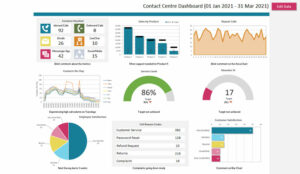The Playvox team discusses the basics of building a great call centre quality assurance (QA) scorecard.
What gets measured gets managed. In the call centre, there’s no shortage of metrics to measure. Agents work hard every day to improve customer satisfaction and to deliver an outstanding customer experience. They also work hard to maximise first call resolution and minimise transfer rate.
Among the myriad Key Performance Indicators (KPIs) to be tracked, the quality assurance team has an important role in focusing on what matters most and driving improvements across the call centre.
Amidst all of the metrics that can be measured, how does a quality assurance team make sure agents who need monitoring and coaching are actually improving?
What Is a Quality Assurance Scorecard?
A quality assurance scorecard plays an important part in transforming the customer experience and empowering agents to deliver the very best possible service.
It’s best to think of the scorecard as a user-friendly, practical tool to measure your agents’ customer service.
At its core, it is a checklist of questions used to assess agent performance and identify their strengths and weaknesses objectively.
The first step in creating a scorecard is to determine which metrics to hold agents accountable to. It is a best practice to keep scorecards concise, covering from 10 to 20 different points.
While the focus ought to be on objective measures such as issue resolution, knowledge and responsiveness, it is also advisable to measure KPIs that pertain to the softer side of customer service, such as empathy and attitude.
How to Create a Scorecard
While it may seem logical and easy to add a bundle of KPIs to a scorecard and start measuring, the first step to developing a QA scorecard is determining the purpose of the scorecard itself.
Start the creation process by answering this single question: What is your endgame with using scorecards?
Focusing on the scorecard’s overall purpose will help determine what ultimately needs to be measured and improved and thus make the results much more valuable.
Once this first critical question is answered, there are several steps to take in ensuring the scorecard is balanced, fair, and effective in improving the customer experience.
- Solicit input from stakeholders – Consider customers, managers, agents, and others inside the organisation
- Decide on a platform – Consider scorecards that are integrated with the CRM system and enable workforce management in a single view
- Implement thoughtfully – Consider the first attempt at implementing a scorecard as provisional in order to make room for possible improvements
- Collect and compile data – Consider presenting data in a way that helps managers identify strengths and weaknesses in the call centre and to coach and reward agents
- Review and refocus as needed – Consider the evolving needs of the call centre and continuously monitor and periodically update your scorecard to reflect the latest needs of your call centre
Key Scorecard Metrics
As we’ve suggested, any number of agent metrics can be tracked using a scorecard.
The following list offers some key criteria that you may want to build into your scorecard and track individually as their own metrics.
- Greeting
- Account Verification
- Contact Information Confirmation
- Problem Solving Abilities
- Protocol Compliance
- Call Handling Skills
- Customer Service Quality
- Call Centre Etiquette
- Script Compliance
- Closure
- Follow-up
You can get more inspiration and detailed suggestions for measuring customer interactions from this list of scorecard items and these scorecard templates.
Each of these measurements should play into broader themes that pertain to a call centre’s goals and objectives beyond improving the customer experience. These can include:
- Responsiveness
- Knowledge
- Attitude
- Alignment with company culture
- Problem resolution
- Follow-up service
One final note on measurement: Not every element of a quality scorecard is applicable or appropriate for every interaction, so “not applicable” may be an acceptable option in some instances.
Once you have the scorecard ready to use, ensure that you are making the most of the scores and data.
Call centre agents play a pivotal role in a customer’s overall experience. When a consumer makes a phone call, they expect to receive the highest standard of service. Measuring the right aspects of agents’ work is vital.
For more insights regarding tools and techniques to improve QA, visit: www.playvox.com
Author: Robyn Coppell
Published On: 9th Apr 2021 - Last modified: 14th Apr 2021
Read more about - Guest Blogs, Playvox















